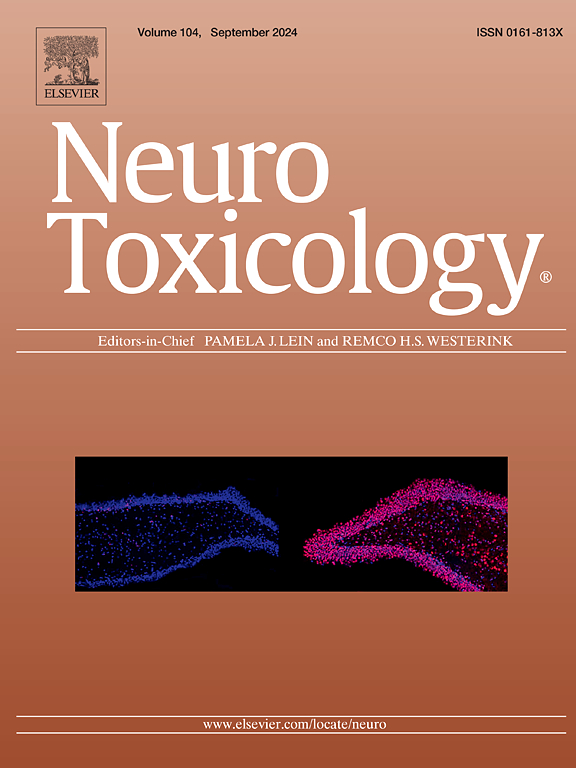高脂肪饮食对空间学习和记忆的影响:性别、APOE基因型和出生后毒死蜱暴露的作用
IF 3.9
3区 医学
Q2 NEUROSCIENCES
引用次数: 0
摘要
环境因素,如接触神经毒物和饮食,在塑造认知功能方面发挥着关键作用,特别是在遗传易感个体中。毒死蜱(CPF),一种有机磷农药,和高脂肪饮食(HFD)单独与认知障碍相关,但它们的联合作用仍然知之甚少。载脂蛋白E (APOE)基因型影响认知能力下降的易感性,其中ε4等位基因是神经退行性疾病的主要危险因素。本研究评估了APOE基因型、性别、早期CPF暴露和HFD对空间学习和记忆的影响。雄性和雌性C57BL/6, apoE3-和apoe4靶向替代(TR)小鼠在出生后10-15天口服CPF,随后进行8周的HFD。在HFD挑战结束时,计算体重增加,并使用Morris水迷宫测试评估空间学习和记忆。结果表明,hfd驱动的体重增加受性别和APOE基因型的影响。所有组都获得了空间学习任务,但出生后CPF暴露影响了某些组的表现。女性的保留率变化更大,表明对环境暴露的敏感性增加。值得注意的是,apoE4-TR女性在CPF或HFD暴露后表现出更好的记忆保留,而apoE4-TR男性在HFD暴露后表现出长期记忆受损。这些发现突出了遗传和环境因素之间复杂的相互作用。了解这些动态对于制定有针对性的营养和公共卫生战略以减轻认知能力下降至关重要。重要的是,饮食建议不应一概而论,而应根据个人情况量身定制,以优化认知健康和疾病预防。本文章由计算机程序翻译,如有差异,请以英文原文为准。
Impact of a high-fat diet on spatial learning and memory: The role of sex, APOE genotype, and postnatal chlorpyrifos exposure
Environmental factors, such as exposure to neurotoxicants and diet, play a critical role in shaping cognitive function, particularly in genetically susceptible individuals. Chlorpyrifos (CPF), an organophosphate pesticide, and high-fat diets (HFD) have been independently associated with cognitive impairment, yet their combined effects remain poorly understood. Apolipoprotein E (APOE) genotype influences vulnerability to cognitive decline, with the ε4 allele being a major risk factor for neurodegenerative diseases. This study assessed the interplay between APOE genotype, sex, early-life CPF exposure, and HFD on spatial learning and memory. Male and female C57BL/6, apoE3- and apoE4-targeted replacement (TR) mice were orally exposed to CPF during postnatal days 10–15 and subsequently subjected to a HFD for 8 weeks. At the end of the HFD challenge, body weight gain was calculated, and spatial learning and memory assessed using the Morris Water Maze test. Results indicate that HFD-driven weight gain was influenced by sex and APOE genotype. All groups acquired the spatial learning task, but postnatal CPF exposure affected performance in certain groups. Retention was more variable in females, suggesting increased susceptibility to environmental exposures. Notably, apoE4-TR females showed improved memory retention following either CPF exposure or HFD, whereas apoE4-TR males exhibited impaired long-term memory after HFD exposure. These findings highlight the complex interactions between genetic and environmental factors. Understanding these dynamics is essential for developing targeted nutritional and public health strategies to mitigate cognitive decline. Importantly, dietary recommendations should not be generalized but tailored to individual profiles to optimize cognitive health and disease prevention.
求助全文
通过发布文献求助,成功后即可免费获取论文全文。
去求助
来源期刊

Neurotoxicology
医学-毒理学
CiteScore
6.80
自引率
5.90%
发文量
161
审稿时长
70 days
期刊介绍:
NeuroToxicology specializes in publishing the best peer-reviewed original research papers dealing with the effects of toxic substances on the nervous system of humans and experimental animals of all ages. The Journal emphasizes papers dealing with the neurotoxic effects of environmentally significant chemical hazards, manufactured drugs and naturally occurring compounds.
 求助内容:
求助内容: 应助结果提醒方式:
应助结果提醒方式:


